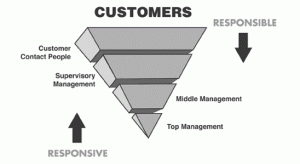An important part of working in a business is being able to express how you’re feeling without being punished for it. Continuing off of Andres Garza’s Blog in which he talks about emotional dissonance in the episode of Black Mirror, Nosedive. We see a character who is swallowed up in a world where people project fake versions of themselves to increase their standing in society. This is representative of a lot of things, one of them being the division of class and hierarchy in the workplace. When the character’s standing begins to drop she loses out on housing opportunities, flights, car rentals, and is treated worse by those who are ranked higher than her.

Like Andres mentioned emotional dissonance, as learned in chapter 3 of the textbook, plays a large role in the episode. However, the hierarchy and ranking system shows the issues of traditional organizational structure, as discussed in chapter 13. The character’s extrinsic motivation to get a higher ranking and have the chance to have more things ultimately plays to her detriment. She becomes unhappy with her life but fakes it as she is also afraid. This can be seen in the workplace where employees mask their distain for their boss and harbour a hatred within themselves, which is unhealthy.

This highlights the importance of communication within companies and why emotional dissonance is detrimental to employee health and job satisfaction. The bottled up emotions cause the woman to go crazy and is a reflection of how employees may lose it when upset, either at work or in their own homes. It is important for people in positions of power to create open lines of communication that allow employees to express themselves, and employers to understand mistakes that they may be making.
Word Count: 291
Work Cited
Garza, Andres. (2017, Mar 27). Black Mirror’s Nosedive: Emotional Dissonance. Andres Garza’s Blog. Retrieved from: https://blogs.ubc.ca/andresgarza/2017/03/27/black-mirrors-nosedive-emotional-dissonance/
Pictures
Nosedive Prison [Online Image] (2016, Oct 21). Retrieved April 2 2017 from:http://www.independent.co.uk/arts-entertainment/tv/features/black-mirror-season-3-episodes-1-6-netflix-ranked-a7373321.html
Nosedive Rating [Online Image] (2016). Retrieved April 2 2017 from: https://www.neondystopia.com/cyberpunk-movies-anime/black-mirror-nosedives-into-social-media-anxiety/






